CISA Releases Forty-One Industrial Control Systems Advisories
This article is contributed. See the original author and article here.
This article is contributed. See the original author and article here.
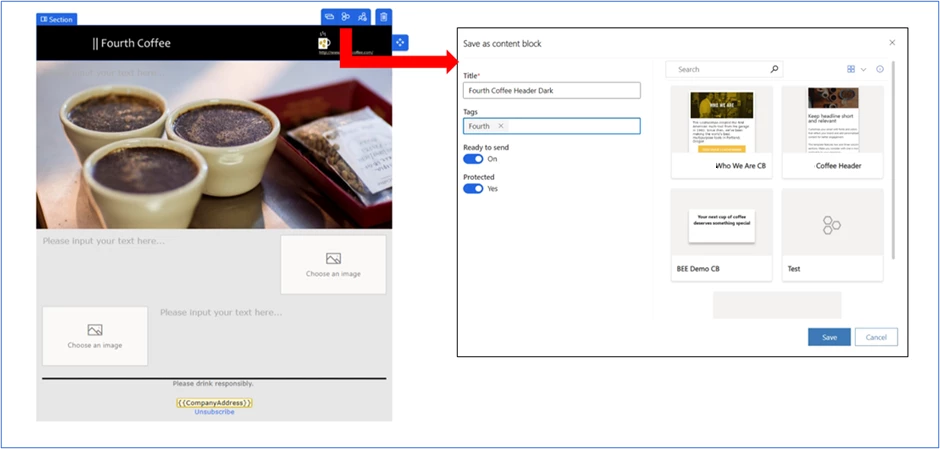
This article is contributed. See the original author and article here.
Your customers’ inboxes are like a firehose that never stops. How do you make sure they’ll notice your communications in the flood? With personalized content tailored just for them. Generic, boilerplate messages make customers feel like they’re just another number. Personalized experiences make your customers feel heard and understood. Over time this builds trust and increases their loyalty.
You’ve collected data and insights that can be used to personalize your marketing content. However, most marketers find it hard to turn their customer data into personalized content at scale. It’s usually complex, and often requires HTML coding or learning database concepts. Lucky for you that Microsoft Dynamics 365 Marketing makes it so easy. Discover all the ways Dynamics 365 Marketing offers to customize your content at scale with an easy-to-use interfaceno coding required!
Imagine you’re a marketer working for Fourth Coffee, an established coffee bean roaster that has relied primarily on its wholesale business relationships. Now you want to expand your business by going direct to consumers with a coffee club and curated digital outreach. A newsletter is a great way to keep your brand top of mind for coffee club members and other customers who have opted in to receive it.
Let’s discover how easy it is to craft a monthly newsletter that keeps your customers wanting more. We’ll create a newsletter template that uses dynamic text and content blocks to include personalized greetings. Then we’ll use conditional content to include a personalized offer that’s aligned to your customers’ interests and matches your business needs.
Let’s start by making sure your newsletter complies with your brand requirements so customers know who it’s from with just a glance. It should always look consistent no matter who sends it out each month, too. We’ll accomplish both goals using content blocks. (Be sure to set up your brand profile to take advantage of more capabilities for maintaining brand consistency.)
Start in the email designer. Pick an existing email template or create your own layout. Include a section at the top (the “header”) with your brand logo. Include another section at the bottom (the “footer”) with contact information and any required legal text. Then insert sections with layouts that contain placeholder content. Save the entire email as a template.
You can also save the header and footer sections as individual content blocks. You can even protect them so that no one else can modify them. Anyone in your team can easily reuse these content blocks in other marketing assets. This not only saves them time; it ensures all required legal text is always included to meet regulatory requirements and provides the consistent look and feel that’s so important for your company’s brand image.

Personalizing your newsletter to greet your customers by name and include unique details catches their attention right away. Dynamics 365 Marketing comes with commonly used dynamic text, such as “FirstName,” that you can insert in your newsletter. You can also define your own dynamic text, such as “Membership number.”
A best practice is to create a library of standard dynamic text so that anyone else on your team can use it to create personalized content.

You don’t have to stop at personalized greetings. Use conditional content to include customized offers and visuals to pique your customers’ interest and make them more likely to click through.
Let’s return to our Fourth Coffee example. To reward your loyal customers, you‘ve decided to make an exclusive offer to your coffee club members. You’ll use conditional content to offer members 30% off an Arabica selection, while non-members will get 10% off. You have two options.
The firstand easiestis to use two different images. Each image contains a different discount. You’ll use the customer’s coffee club membership status to display the correct image.
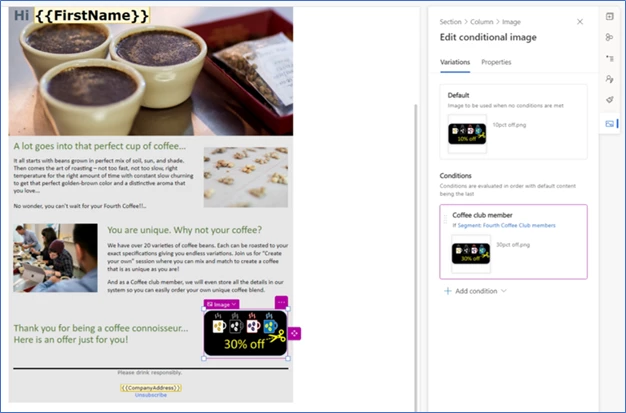
The second option is to use conditional content at the section level. This allows you to personalize images, columns, text, etc., in the section. In the example below, we overlayed dynamic text on the same background image. This way, the specific discount value can be inserted from any table in Microsoft Dataverse where discounts are stored. It can be updated automatically, and marketers don’t need to change anything in the email. This option is particularly useful for limited-time offers such as Black Friday discounts or a flash sale.
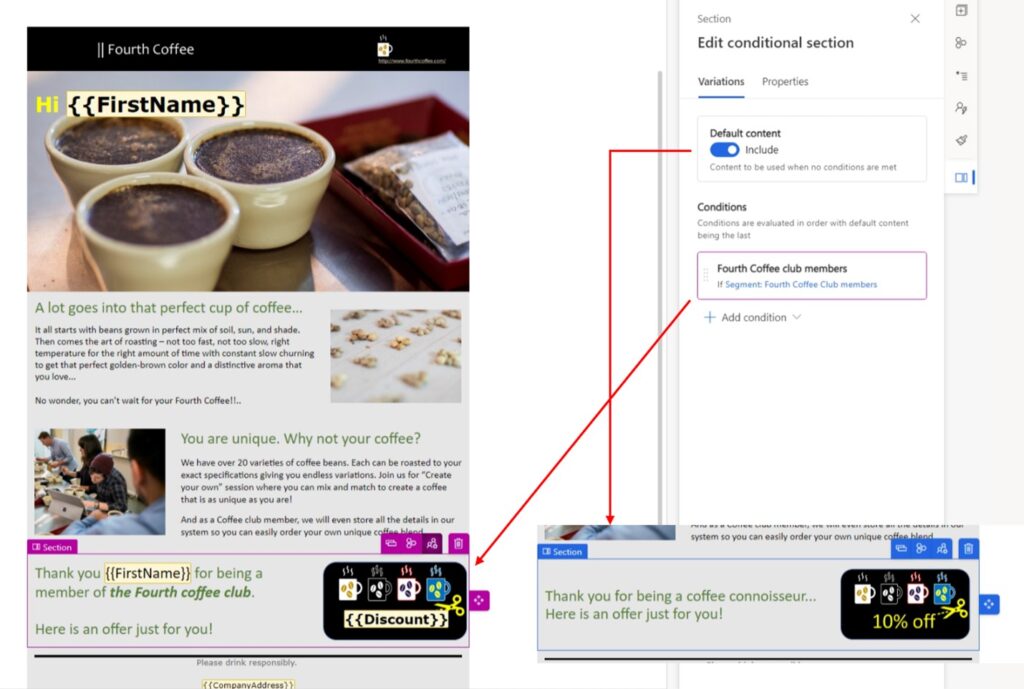
You can save the entire conditional section as a content block. You or your team can quickly and easily reuse this personalized offer in other emails and reduce errors.
And here’s the perfectly personalized newsletter your club members and non-members will receive:
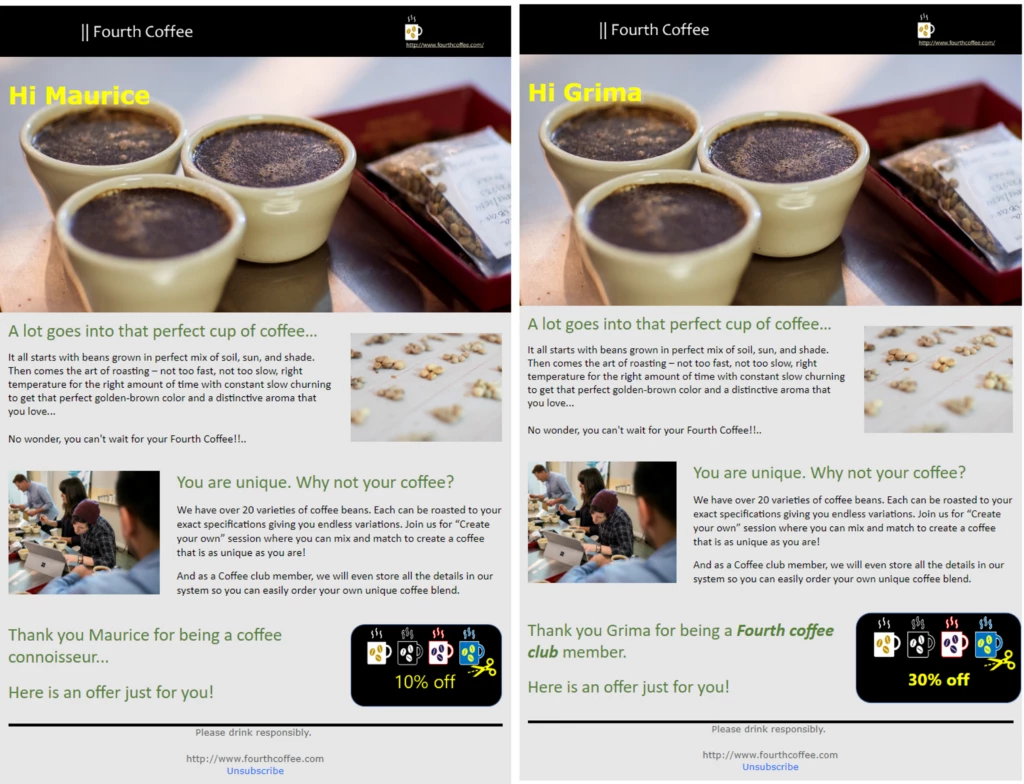
There are countless other ways to use conditional content in your email marketing campaigns. For instance, you can include an image that reflects your customer’s interests or highlights a landmark in their city or state. You might customize your footer by including conditional social links, legal text, and unsubscribe settings based on your recipient’s country.
With just a few clicks, you can create a library of powerful and reusable content blocks that can help you personalize future messages in no time, while ensuring brand consistency.
Learn how Dynamics 365 Marketing can help you use your customer data to create personalized content that engages your customers, strengthens your brand, and meets your business needs:
Not yet a Dynamics 365 Marketing customer? Take a guided tour and start a free trial!
The post Engage customers using highly personalized content—easily, efficiently, and at scale appeared first on Microsoft Dynamics 365 Blog.
Brought to you by Dr. Ware, Microsoft Office 365 Silver Partner, Charleston SC.
This article is contributed. See the original author and article here.
As a Microsoft 365 admin, you need to deploy services for your users and your organization efficiently, comprehensively, and securely. Getting the most out of your investment has everything to do with how quickly you can configure, deploy, and get the right products to the right users. To help minimize time to deployment and free you up to do more, the Advanced deployment guides & assistance page in the Microsoft 365 admin center along with setup.microsoft.com deliver just that – a streamlined approach to Microsoft 365 deployment built on FastTrack best practices. Resources available on support.microsoft.com or learn.microsoft.com offer a wealth of information, training, certification and more. On the other hand, the Microsoft 365 admin center curates relevant guides specific to your tenant, offering you the most actionable information to help you get your Microsoft 365 apps and services deployed to your organization. Today we are announcing a series of improvements to the deployment guides to help you simplify deployment of Microsoft 365.
To help you easily find guides for the services you’re deploying, we’ve updated the search tools, recommendations, and layouts for the Advanced deployment guides & assistance page in the Microsoft 365 admin center and at setup.microsoft.com. Additionally, to help you track key metrics over time, these new layouts include views that highlight guides for Secure Score (pictured below), as well as the Compliance Score and Adoption score (coming soon).
The Secure Score view on the advanced deployment guides & assistance page.As a Microsoft 365 admin, you’ll likely need to communicate and share your deployment progress with relevant stakeholders. Rather than documenting and summarizing progress for each deployment process along the way, you can now save valuable time by exporting your progress in Excel and share your progress as needed.
Secondly, prioritization is key. With the breadth of services available in your Microsoft 365 subscription, it’s important to prioritize and focus on the highest impact services first. In this update, you can now view the most important actions front and center in the Suggested guides section. In future updates, these suggestions will be tailored to your configuration and licenses.
Lastly, to help you stay informed on the latest information about advanced deployment guides, you can now use tags to notify you when a new or updated guide has been released since your last visit to the page.
The suggested guides view on the advanced deployment guides & assistance page.
Setup.microsoft.com is the home for advanced deployment guides outside the Microsoft 365 admin center. Now, all the same guides in Microsoft 365 admin center are available on setup.microsoft.com, so admins who don’t have permissions for Microsoft 365 admin center can access the information they need. For admins of adjacent products, partners, or other stakeholders, setup.microsoft.com offers step-by-step deployment information. It serves as a useful learning and guidance resource accessible those who can’t directly sign in to the Microsoft 365 admin center, or who only have permissions to access other admin centers. The site also helps anyone get informed about deployment as they discover and try Microsoft 365 services before making a purchase.
Key updates to this site include:
A side-by-side image demonstrating the updated design of the setup.microsoft.com website with new areas to find guides by product or scenario.
Recently we’ve released a new advanced deployment guide for setting up your Microsoft Zero Trust security model. Coming in the first quarter 2023, we’re planning the release of a new guide for Windows 365 Cloud PC configuration. Check out both locations for the new guides.
Microsoft 365 deployment guides give you tailored guidance and resources for planning and deploying your tenant, apps, and services. They explain how to set up products, enable security features, deploy collaboration tools, and provide scripts to speed up advanced deployments. We hope you will find these recent enhancements to make for a more user-friendly and navigable environment as you explore and use the Microsoft 365 advanced deployment guides.
Continue the conversation by joining us in the Microsoft 365 community! Want to share best practices or join community events? Become a member by “Joining” the Microsoft 365 community. For tips & tricks or to stay up to date on the latest news and announcements directly from the product teams, make sure to Follow or Subscribe to the Microsoft 365 Blog space!
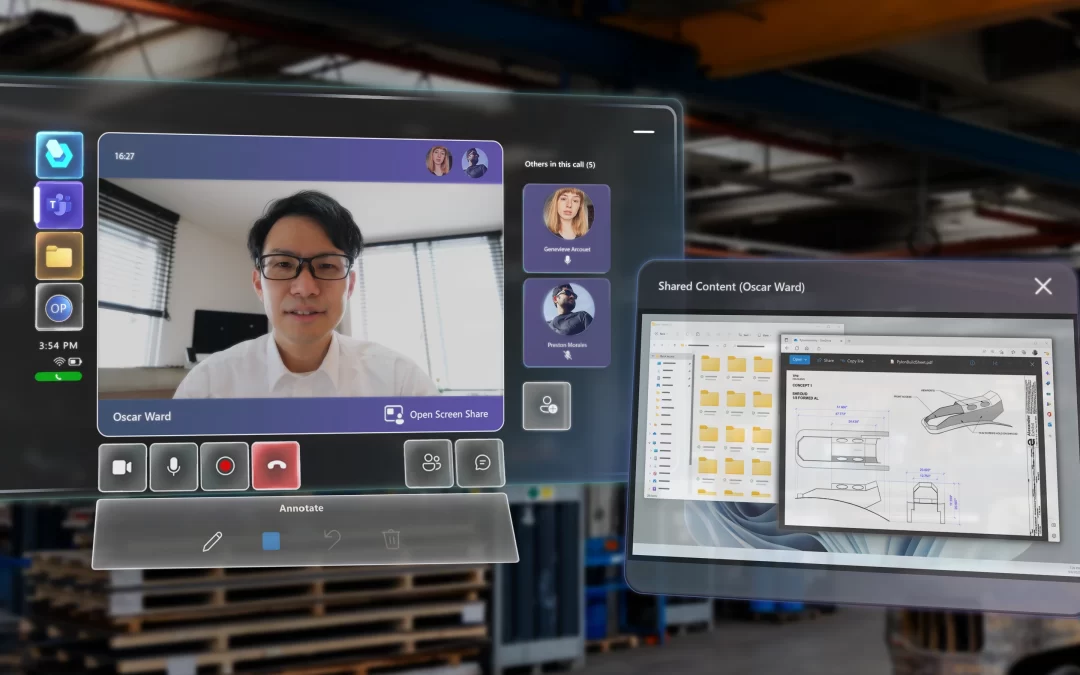
This article is contributed. See the original author and article here.
Microsoft HoloLens 2 customers are using mixed reality to expedite the ways they ensure process compliance, improve efficiency, and learn on the job with step-by-step holographic instructions in Microsoft Dynamics 365 Guides. They’ve also used real-time video calls using Microsoft Teams meetings in Microsoft Dynamics 365 Remote Assist. Now they can do both at the same time with the latest release of Dynamics 365 Guides, which combines these two mixed reality apps into a single seamless experience. Users can intuitively switch between process and collaboration activities or do both simultaneously. Easy access to the information they need and the people they’re working with is at their fingertips, ensuring everyone can take action with confidence in the industrial metaverse.
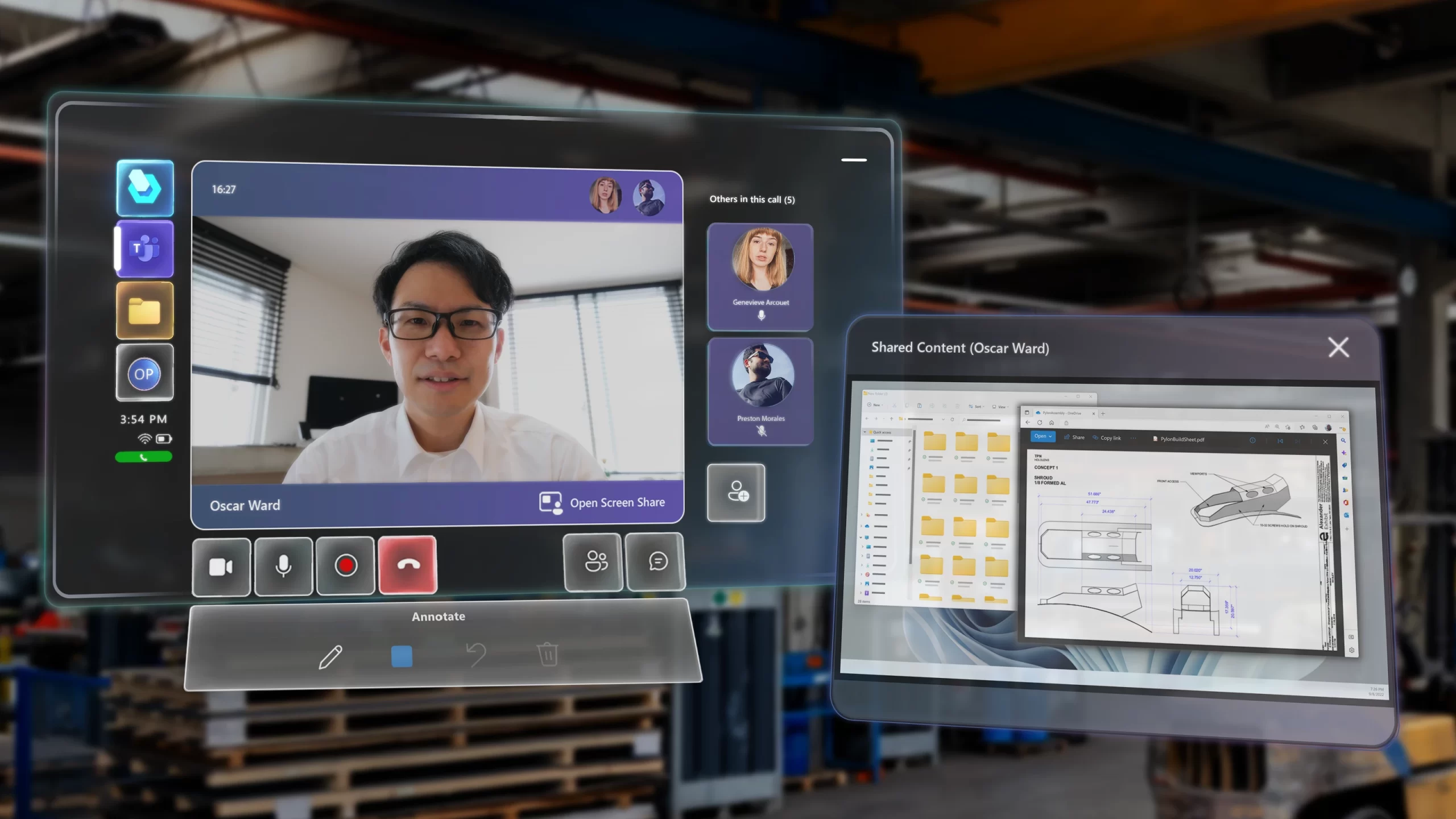
People working on desktop computers and mobile phones have enjoyed sharing their local screens with one another for years, and now HoloLens 2 users can keep up with what people in the meeting are seeing too. This inclusive definition of hybrid work helps people join a meeting on the device best suited for their environment and workflow. HoloLens 2 users see a live video stream of any shared screen as a hologram in their space. The holographic shared content can be freely moved and sized to meet the demands of spatial workflows.
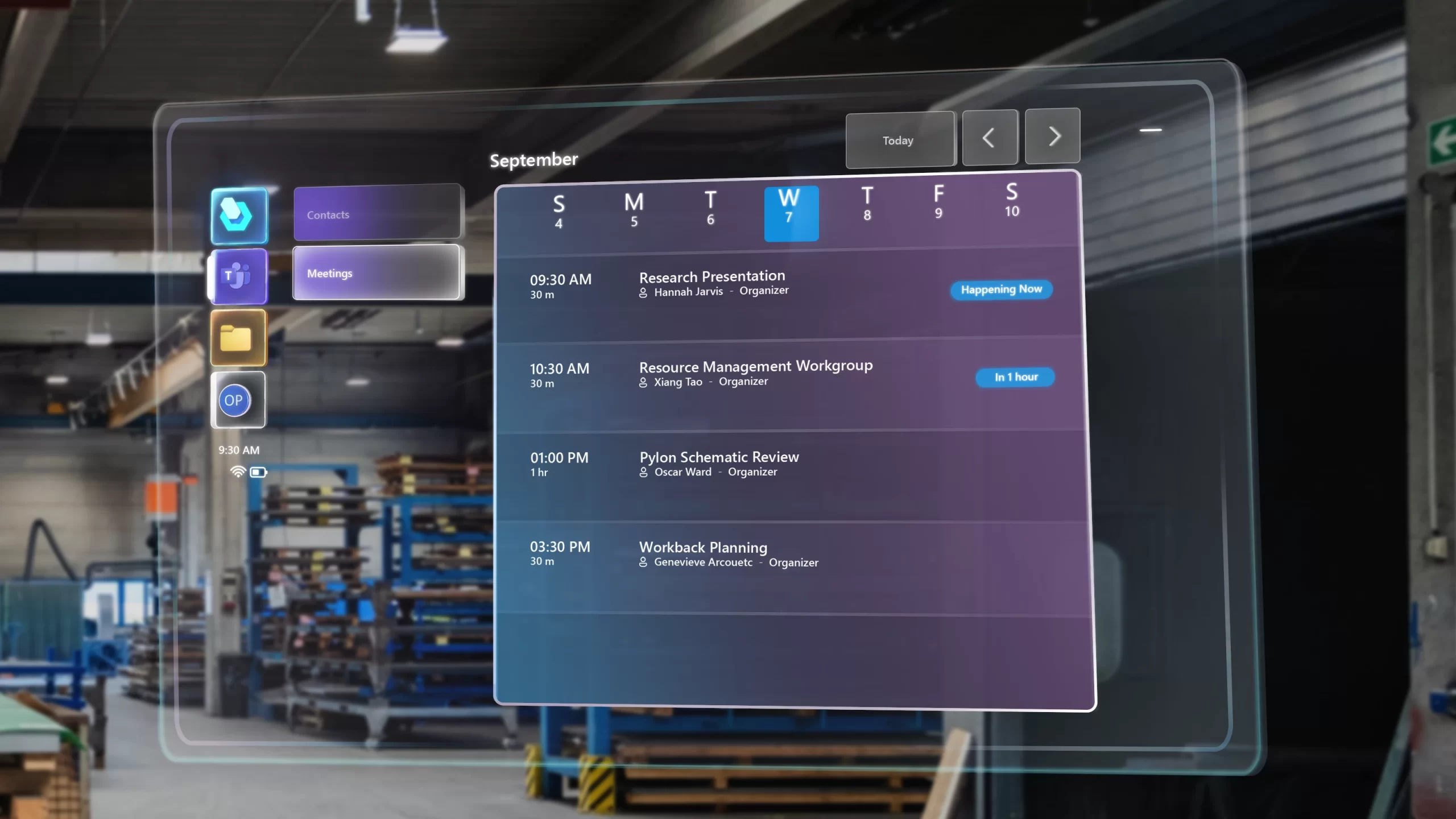
When immersed in Dynamics 365 Guides, users can swiftly check their calendar to see what’s on the agenda for that day, looking forward to prepare for tomorrow or backward in time to recall what happened yesterday. They’re supported with real-time indicators for current and upcoming meetings on each agenda line. HoloLens 2 users can call people directly, browse and add Teams contacts to ongoing calls, or join a regularly scheduled meeting just as they would do on any other device. One meeting, any device, anywhere. These meetings can be recorded as usual, so that training or other step-by-step procedures and actions happening on HoloLens 2 are preserved for others to view later.
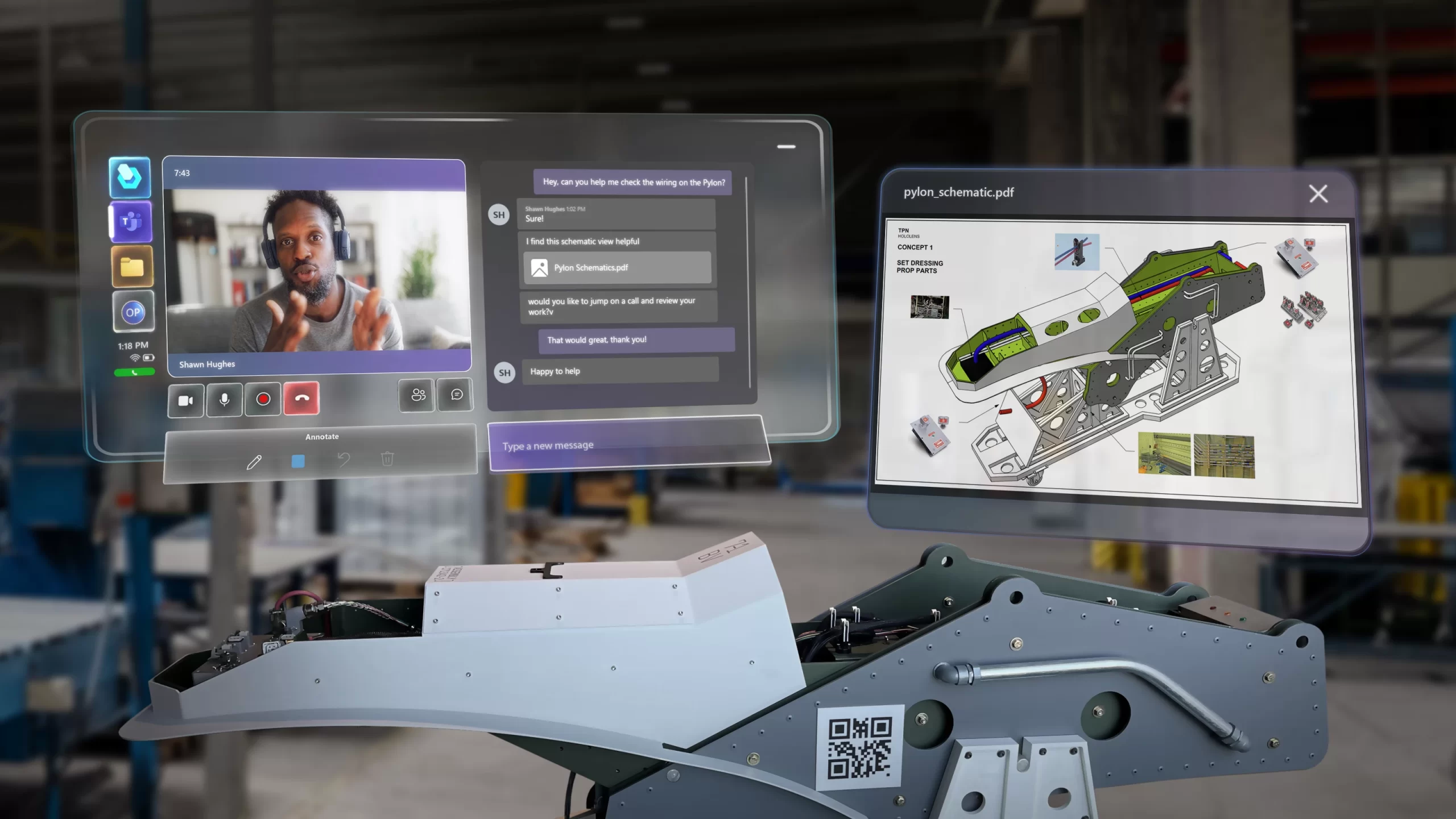
When collaborating with remote participants in a one-on-one or group Teams call, HoloLens 2 users can now contribute to the conversation through text chat and access any image or PDF file shared there as holograms. These holographic windows can be opened or closed at will and resized or repositioned with ease. The HoloLens 2 user is in control of where and how they absorb the information while working in the real world.
The addition of OneDrive file access at any time brings a world of reference material to Dynamics 365 Guides users. This new feature ensures people have the information they need, whenever and wherever they go. No desk or laptop required.
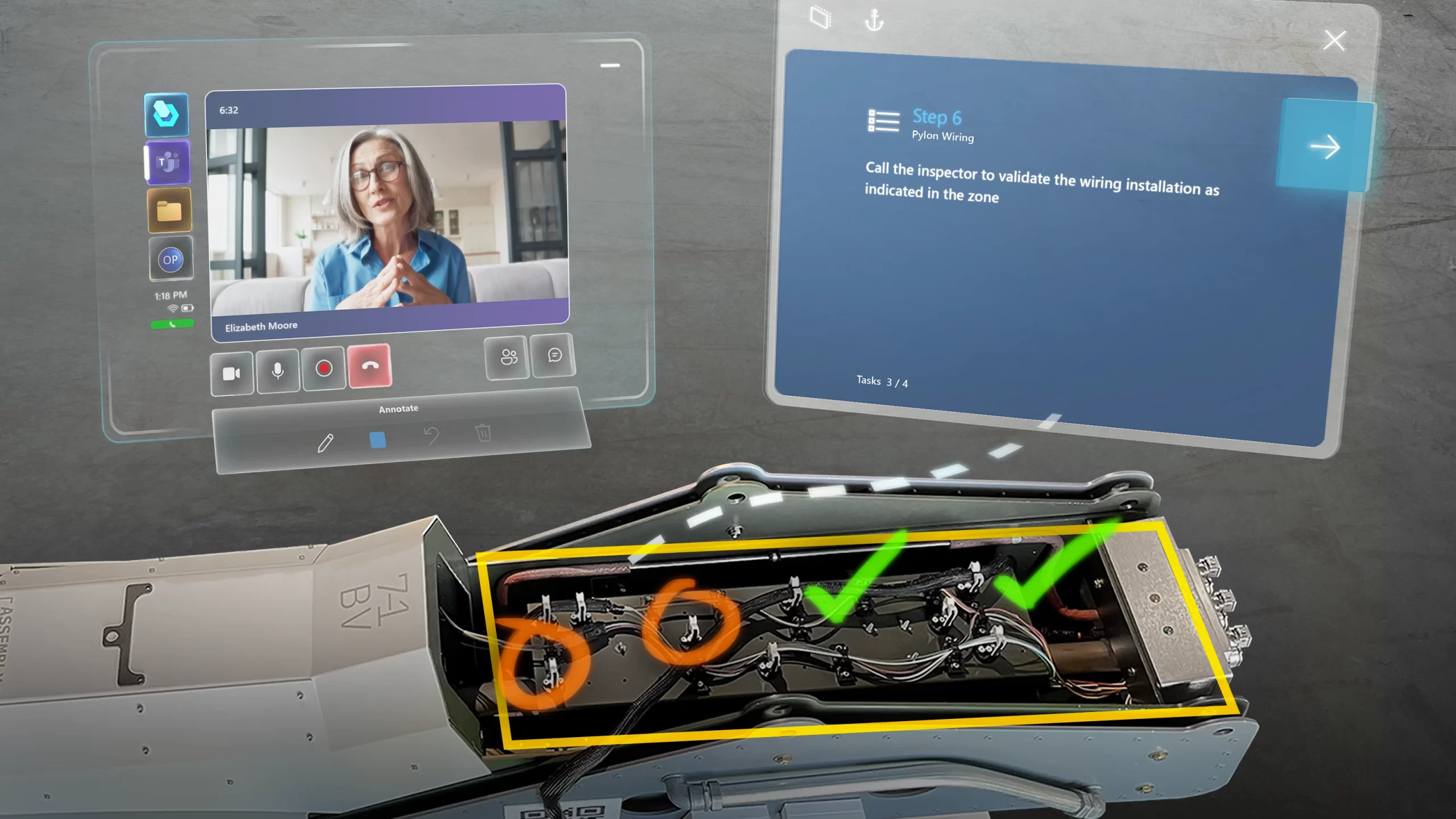
With the mixed reality toolbar in Teams desktop, remote participants can add 3D markup to the real world. The desktop user draws on the screen and their ink is automatically attached to the space in view for the HoloLens 2 user. This type of 2D to 3D interaction is at the heart of hybrid work in the industrial metaverse.
Best of all, these systems work out of the box. Simply sign in to Dynamics 365 Guides on HoloLens 2 with your work email address and get a familiar view of Teams and OneDrive.
Here are some common ways to use the new features in an impromptu call, one-on-one, or as part of a scheduled Teams meeting on the calendar:

Transform your workforce, build a more agile factory, unlock innovation, and deliver new services using Dynamics 365 Guides and HoloLens 2. Ready to empower your frontline employees?
The post Holographic Microsoft Teams features empower hybrid collaboration in the industrial metaverse appeared first on Microsoft Dynamics 365 Blog.
Brought to you by Dr. Ware, Microsoft Office 365 Silver Partner, Charleston SC.
This article is contributed. See the original author and article here.
Drupal has released security updates to address vulnerabilities affecting H5P and the File (Field) Paths modules for Drupal 7.x. An attacker could exploit these vulnerabilities to access sensitive information and remotely execute code.
CISA encourages users and administrators to review Drupal’s security advisories SA-CONTRIB-2022-064 and SA-CONTRIB-2022-065 and apply the necessary update.
Recent Comments